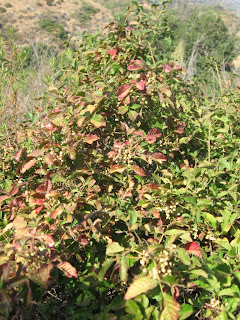

 Poison ivy along the trail in Eaton Canyon, Pasadena, July 2010. The two bottom photos are of the same plant, from a short distance and then closer up.
Poison ivy along the trail in Eaton Canyon, Pasadena, July 2010. The two bottom photos are of the same plant, from a short distance and then closer up.Poison ivy is well-known for its ability to cause a severe rash and blisters on the skin wherever you brush against the plant.
Poison ivy grows throughout most of North America. You can recognize it by the way that the leaves grow in groups of three, and by the almond-like shape of the leaves and their shiny, reddish color when mature. The plant bears sprays of greyish-white berries as early as late June here in southern California. It can grow as a shrub, as a ground cover, or as a vine on another tree or support. The leaves usually have small notches along the edges, but some plants have more notches than others, and even some leaves on the same plant are more notched. When in doubt, stay away!
Do not touch even dead leaves, as the irritant oil can remain active for years. Do not touch pets that have come into contact with the plant. Do not burn any part of the plant or breathe the smoke from an accidental fire. Do not eat it.
Treat poison ivy rash with calamine lotion, an oatmeal or baking soda bath, or with baking soda mixed with a little water to make a runny paste. The rash can last from 1 to 4 weeks. Wash your skin thoroughly with lukewarm water as soon as possible after contact. The rash is not contagious, but you can transfer the irritant to another part of your body or to someone else if you still have some on your skin. If you have touched poison ivy, do not touch your eyes or rub them, even with part of your clothing that may have come into contact with the plant.
Poison oak, a similar species, grows in western North America.
Read more about poison ivy and poison oak at Wikipedia.


No comments:
Post a Comment